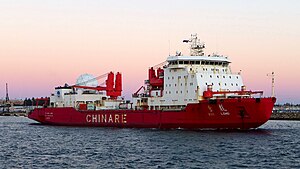 Xue Long departing from Fremantle in March 2016
| |
| History | |
|---|---|
| Name | Xue Long (simplified Chinese: 雪龙; traditional Chinese: 雪龍; pinyin: Xuě Lóng) |
| Operator | Polar Research Institute of China[1] |
| Port of registry | Shanghai, People's Republic of China |
| Builder | Kherson Shipyard, Ukraine |
| Yard number | 6003[2] |
| Laid down | 1 January 1990[3] |
| Completed | 1 March 1993[1] |
| Refit | 2007 |
| Identification | |
| Status | In service |
| General characteristics [1] | |
| Type | Research vessel |
| Tonnage | |
| Displacement | 21,025 tons |
| Length | 167 m (548 ft) |
| Beam | 22.6 m (74 ft) |
| Draft | 9 m (30 ft) |
| Ice class | CCS B1* |
| Installed power | |
| Propulsion | Single-shaft, ducted controllable-pitch propeller |
| Speed |
|
| Range | 20,000 nautical miles (37,000 km; 23,000 mi)[5] |
| Complement | 34 crew, 128 passengers or researchers |
| Aircraft carried | One helicopter (e.g. Kamov Ka-32A (Snow Eagle) used by Chinare or Harbin Z-9)[citation needed] |
| Aviation facilities | Helipad |
| Notes | 100 m2 (1,100 sq ft) laboratory space |
Xue Long (simplified Chinese: 雪龙; traditional Chinese: 雪龍; pinyin: Xuě Lóng; lit. 'Snow Dragon', shway-lung)[6] is a Chinese icebreaking research vessel. Built in 1993 at Kherson Shipyard in Ukraine, she was converted from an Arctic cargo ship to a polar research and re-supply vessel by Hudong–Zhonghua Shipbuilding of Shanghai by the mid-1990s. The vessel was extensively upgraded in 2007 and 2013.
Until 2019, Xue Long was the only Chinese icebreaking research ship in service. A second Chinese polar icebreaker named MV Xue Long 2,[7] slightly smaller but more capable, entered service in July 2019.[citation needed]
- ^ a b c "Xue Long (93S1010)". Register of ships. China Classification Society. Retrieved 30 June 2023.
- ^ a b "Xue Long (8877899)". Sea-web. S&P Global. Retrieved 2015-10-21.
- ^ China Classification Society Archived 2014-01-06 at the Wayback Machine
- ^ "Xue Long (8877899)". Equasis. Ministry of Ecology, Sustainable Development and Energy. Retrieved 2012-09-12.
- ^ A Brief Introduction of R/V Xuelong. Chinese Arctic and Antarctic Administration. Retrieved 2012-07-17.
- ^ Alan Boyle (2013-12-30). "How icebreakers work — and why they sometimes don't work". NBC News. Archived from the original on 2013-12-30.
- ^ "First Chinese-built polar icebreaker gets name". Xinhua. 10 October 2017. Archived from the original on 20 April 2018. Retrieved 19 April 2018.